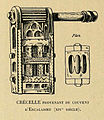Ratchet (instrument)
 | |
| Classification | Idiophone |
|---|---|
| Hornbostel–Sachs classification | 112.24 (Scraped wheels – cog rattles or Ratchet) |
| Related instruments | |
| Derkach | |
A ratchet, rattle or noisemaker is a musical instrument of the percussion family. It operates on the principle of the ratchet device, using a gearwheel and a stiff board mounted on a handle, which rotates freely. Variants include the gragger or grogger (Yiddish: גראַגער) used in Judaism, the raganella, the football rattle and the policeman's rattle.
Method of playing[]
The player holds the handle and swings the whole mechanism around. The momentum makes the board click against the gearwheel, producing a clicking and rattling noise. A popular design consists of a thick wooden cog wheel attached to a handle and two wooden flanges that alternately hit the teeth of the cog when the handle turns. Alternatively, smaller ratchets are sometimes held still or mounted and the handle turned rapidly by the player. The mounted ratchets allow for greater control of the duration and timing of the sound. This allows the ratchet to be used like a snare drum, placing sustained rolls in precise durations of time. Dynamics are controlled by the rate at which the ratchet is rotated.[1]
Uses[]
Music[]
The rattle is used in such compositions as Richard Strauss's Till Eulenspiegel's Merry Pranks and Arnold Schoenberg's Gurre-Lieder.
Sport[]
Up until the early 1970s, this type of rattle was a common sight used by fans at soccer and rugby matches.
Policeman's rattle[]
In the 18th and 19th centuries, a policeman's rattle was used by British[2] and Australian[3] policemen to summon assistance.[4] They were used to warn of poison gas attack in the trenches of the First World War and issued to British police and ARP wardens during the Second World War, to warn of the presence of poison gas.[5][6]
In Jewish tradition[]
In Judaism, the gragger (also grogger or gregger; from Yiddish גראַגער) is used for the holiday of Purim. The gragger is used every time Haman's name is mentioned during the reading of the Megillah.[7] Because Haman persecuted the Jews, the noise is supposed to symbolically drown out his name (although every word of the Megillah, including Haman's name, must be heard clearly; therefore, the words are often repeated after the sounding of the gragger). The gragger was developed to help make noise during the reading.[8]
Gallery[]
Ratchet used for poison gas warning in World War II

Raspel

In some European churches, a ratchet known as a crotalum is used instead of bells during the Paschal Triduum, the three days before Easter Day[9]

A Purim gragger, a kind of ratchet used in Judaism
A plastic version of the gragger

14th century French ratchet
See also[]
- Derkach, a Ukrainian version of the ratchet.
References[]
| Wikimedia Commons has media related to Ratchets (instrument). |
- ^ Karl Peinkofer and Fritz Tannigel, Handbook of Percussion Instruments, (Mainz, Germany: Schott, 1976), 152-153.
- ^ Cross, David (2011-02-17). "On the Beat in Birmingham - Rules and regulations". BBC. Retrieved 11 March 2014.
Police whistles came much later; the early Victorian constable would have carried a small wooden rattle.
- ^ "Evolution of the Victoria Police uniform". The Australian. Retrieved 11 March 2014.
Police rattle from the late 19th century. Used by early police officers in Melbourne, to call for assistance or sound warnings... Later replaced by a whistles.
- ^ Taylor, J. "The Victorian Police Rattle Mystery" Archived 2010-02-18 at the Wayback Machine The Constabulary (2003)
- ^ jtalarico (2015-08-26). "8 Objects Used By Air Raid Wardens During The Blitz". Imperial War Museums. Retrieved 2017-10-26.
- ^ "Gas Rattle". www.iwm.org.uk. Retrieved 2017-10-26.
- ^ Einstein, Stephen J.; Kukoff Lydia (1989). Every person's guide to Judaism. URJ Books and Music, ISBN 978-0-8074-0434-8
- ^ Karesh, Sara E.; Hurvitz, Mitchell M. (2006). Encyclopedia of Judaism. Infobase Publishing, ISBN 978-0-8160-5457-2
- ^ "The Fascinating Story Behind the Rarest of Liturgical Devices: the Crotalus". ChurchPOP. March 23, 2016.
External links[]
- Purim
- Scraped idiophones
- Hand percussion
- European percussion instruments
- Orchestral percussion
- Percussion instruments used in worship
- Unpitched percussion







